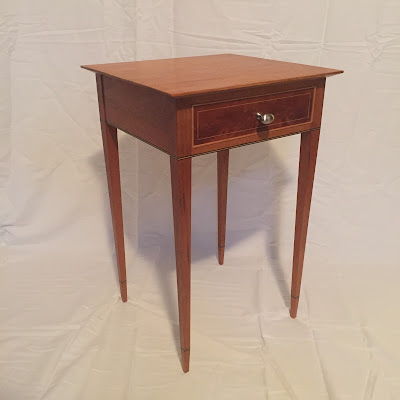Since progress on the nightstands is a little sluggish, I thought I would post some pictures of projects I have completed in the past.
The first project I made start to finish was a jewelry box from mahogany and poplar with cherry accents in the interior. I had a lot of fun making this, the dovetails turned out great and it was my first experience with inlaying hinges. A special thank you goes out to Tim Lovett of Lie-Nielsen Toolworks who helped me decide what to do about the bottom of the inside tray. I was worried that a solid piece of wood would present a problem during the course of expansion; however, he assured me that, since I was building the box in the summer, the bottom would only get smaller, so it would not be a problem.
 |
| The deep red mahogany is a strong contrast against the greenish-white poplar. |
 |
| The houndstooth dovetails of the tray. It sits on dividers that rest in stopped dados in the main case. |
I was too busy to complete any projects during the last school year, so it was long time before I built another one. Looking ahead to the summer, I decided to build a new workbench. I had become fed up with the one I bought a few years earlier from Harbor Freight (what a mistake that was), so I decided I deserved to make a new one. I wanted to build a split-top roubo, because it is perfectly suited to hand work, and could easily be used for occasional power tool work. I began making preparations for it in the spring. What an investment that was! I built this bench almost entirely by hand, including ripping the sixteen-quarter poplar legs and eight- and six-quarter ash for the top. I knew I was going to struggle with flattening the top with my number six fore plane, so I called up my friend Tommy MacDonald, and he took time out of his day to invite me over to his shop in Canton to run the two top sections through his powerful planer. I would estimate that he save me five to six hours of work that I would otherwise have had to do by hand. He did all that for me completely free of charge, which really shows how selfless he is. I don't think I will ever be able to repay him for that, but he has really inspired me to do even better work on my bench and to be a better person. The Benchcrafted vises are so sweet. All it takes is one quick spin of the wheel or tommy bar and the vise cinches down tight. I don't think I even needed to line the jaws with leather, but why the heck not?
 |
| I can never take a good photo in my shop. |
 |
| I toothed the benchtop to give it some extra grip. |
The first project I completed on my new bench was a cherry bedframe with a tiger maple frame-and-panel headboard. This is the biggest piece of furniture I have built by far, which made for some workholding challenges. The long rails are, I believe, seven inches longer than the length of my benchtop, so I clamped the boards down and took stopped shavings with my handplanes and scraped and sanded to blend any spots where the shavings didn't quite overlap. The tiger maple panels were resawn from an eight inch wide eight-quarter board. To do this I took the boards to my high school, which has a bandsaw, and it made quick work of this hard wood. The finish for the cherry frame was rather straight forward. Two coats of a 2:1 mineral spirits to varnish blend and a quick coat of wax. The tiger maple was much trickier. I used a mixture of W.D. Lockwood's Golden Amber water-based dye that was thinned down a twelfth of the recommended concentration. I used several thin coats and wiped away the excess as soon as possible. This allowed me to really highlight the figure, because it absorbed much more of the finish compared to the straight grain. I followed that up with three coats of the 2:1 mineral spirits to varnish blend that I used on the frame. This really made the grain pop. I then used a coat of wax over each panel. It is best to do the finishing on panels BEFORE they are set into their frame.
 |
| A good view of the entire frame. |
 |
A close up of the headboard.
|
In the next few days I should have a post updating you all on the progress of the nightstands, so stay tuned. Happy woodworking!




































